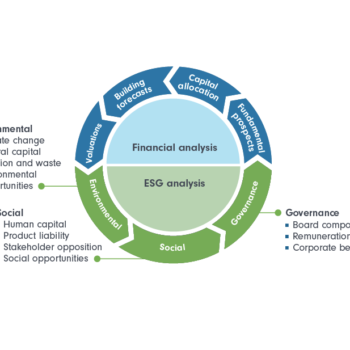Written by Catherine Audette
In the age of corporate social justice, sustainability risk management can help firms make better choices for the planet while staying competitive.
In the Global Risk Report 2019, the World Economic Forum (WEF) emphasized insufficient climate-change mitigation and adaptation as one of the most impactful and likely risks humanity faces. Ignoring climate change risks will lead to dire effects across the world.
Some businesses are already suffering from environmental degradation. For instance, agricultural businesses are experiencing high levels of crop loss from droughts while unusually strong hurricanes destroy businesses and warehousing facilities.
We primarily think of these types of visible risks when discussing negative economic effects caused by climate change. However, climate change will affect businesses you would never suspect like tourism. For example, tourism in the Alps will suffer as warmer winters reduce the financial viability of winter tourism.
What is sustainability risk management?
Though it may be frightening to realize how climate change will transform our economy, our awareness also offers opportunities to invest in solutions to manage these risks. This is where sustainability risk management (SRM) comes in. This concept is based on the alignment of a firm’s economic goals with its environmental policies. In layman’s terms, sustainable risk management aims to ensure sustainable business practices without compromising the bottom line. Using an SRM strategy can help optimize each aspect of the business and identify issues before they are integrated into the core business process, making them easier to rectify. Moreover, SRM does not minimize the role of profit in business, making it a realistic and attainable plan for firms who might shunmore extreme environmental strategies focused on degrowth.
How do we implement it?
Comprehensively integrating an SRM strategy into a firm’s practices can be easier said than done. According to Yilmaz & Flouris in their 2009 paper entitled “Managing corporate sustainability: Risk management process based perspective,” it “requires holistic and systematic integration of ecological, socioeconomic, and corporate risk factors in the business management”, which is no easy task. But some academics have suggested a method to optimally utilize SRM. In their paper “Company Risk Management in Light of the Sustainability Transition”, Schulte and Hallstedt suggest these steps:
- Identify the effects of sustainability issues on internal and external stakeholder value.
- Actively include sustainability in objective setting and cascading objectives across the levels of the organizational hierarchy.
- Develop concrete support for identifying, assessing, and managing economic sustainability risks.
A successful implementation of the SRM strategy leads to increased sustainability reporting and ethically sound business practices. Companies both large and small can leverage SRM, boosting the economy as a whole. For instance, Unilever has created fundamental principles to ensure they conduct business ethically. One of the company’s fundamental principles is that “Business is conducted in a manner which embraces sustainability and reduces environmental impact”. By utilizing SRM, this multinational conglomerate benefits many aspects of the economy, from food to cleaning products to other consumer goods.
How can SRM revolutionize our economy?
Though it is growing, the sustainable economy is still a niche market. Therefore, instead of trying to grow sustainable businesses, the focus should be on integrating SRM with the mainstream economy to amplify its impact. The SRM strategy could transform the business models of large corporations who dominate the mainstream economy, pushing them to shift from consumerist models to focus more on sustainable business. Though this may limit short term growth, sustainable business leads to higher profits over the long term, partly due to reduced resource depletion as well as less money spent adapting to climate change.
All companies could profit from using an SRM strategy, but I believe the financial services industry in particular could generate the biggest benefit. This sector faces the largest financial risks related to climate change. Thankfully, these risks can be managed quite affordably. In fact, financial companies reported a financial risk of $677 billion that would cost only $2.2 billionto manage. It is much cheaper to address these risks preventatively rather than wait too long, making SRM a smart move both financially and environmentally.
In addition to tackling their own risks, financial service firms can leverage the large pools of capital at their disposal to help mitigate the climate-related impacts of businesses in various sectors. They can invest in the creation of a sustainable economy by prioritizing investments in sustainable businesses. This in turn would motivate corporations to incorporate sustainability to improve their investment attractiveness. I think a more sustainable financial industry would catalyze a snowball effect which would transform the entire economy.
Sustainability risk management is the most effective and realistic strategy for creating a sustainable economy, as it allows companies to achieve the best of both worlds: financial success and climate risk mitigation.
What can you do as a consumer to encourage this transition?
- Do your research on companies before buying from them
- Support businesses using a form of SRM
- Avoid purchasing from businesses utilizing unsustainable business practices
- Contact your financial service provider and ask what can be done to invest in more sustainable ventures
- If you invest in the stock market on your own, switch to stocks of businesses using a form of SRM
References:
Schulte, J., & Hallstedt, S. (2018). Company Risk Management in Light of the Sustainability Transition. Sustainability, 10(11), 4137. doi: 10.3390/su10114137
Yilmaz, A. K., & Flouris, T. (2010). Managing corporate sustainability: Risk management process based perspective. African Journal of Business Management, 4(2), 162–171.













No Comments